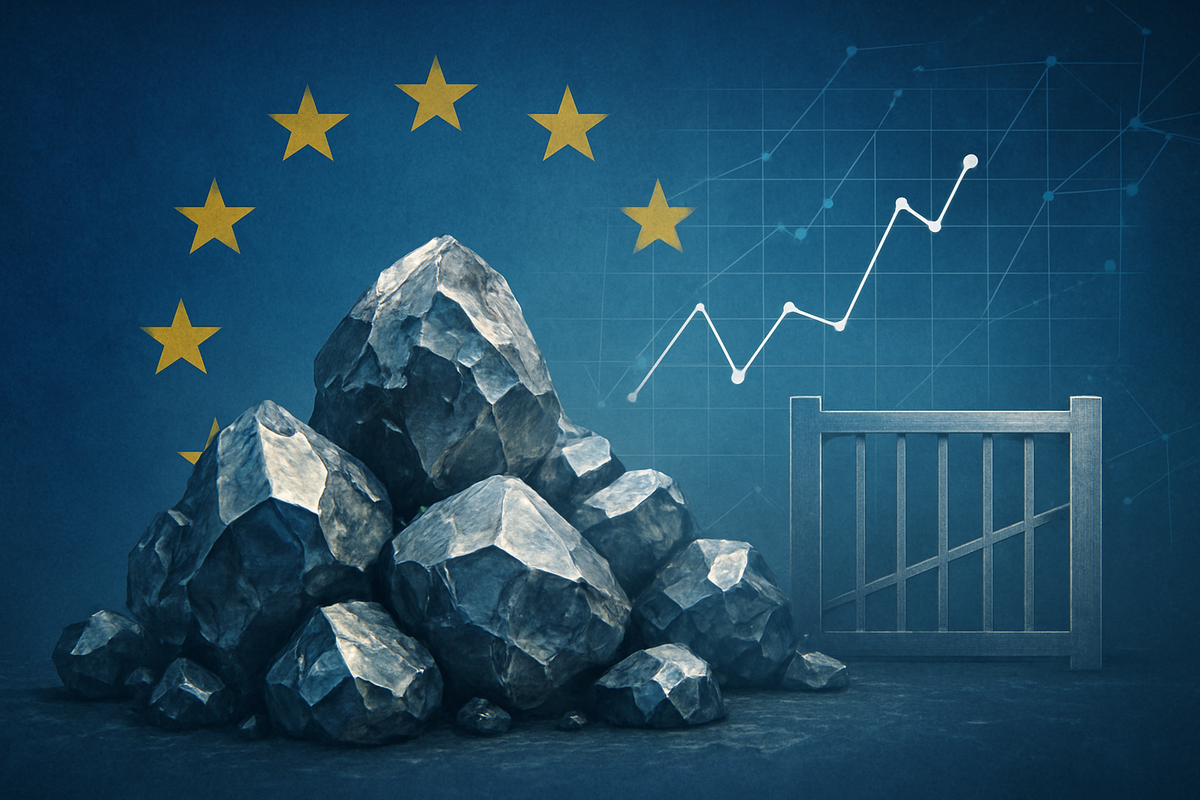
Brussels, Belgium – November 21, 2025 – The European Commission has officially enacted definitive safeguarding measures on imports of certain ferroalloys, a strategic move designed to shield the European Union's domestic industry from a surge of low-priced imports. These measures, which came into effect on November 18, 2025, introduce a complex system of country-specific tariff-rate quotas (TRQs) and price thresholds, marking a significant shift in EU trade policy aimed at bolstering industrial resilience and supply chain security.
The immediate implications for the EU commodity market are a mix of clarity and ongoing uncertainty. While the published regulation provides much-needed operational guidance, it also grants the EU flexibility to modify the measures if circumstances change. Market participants are already grappling with the new quota-based trading dynamics, anticipating adjustments in sourcing strategies and potential price shifts, particularly as major non-EU producers face reduced duty-free access to a crucial market.
Definitive Safeguards Implemented to Protect Critical EU Industry
The European Commission's decision to implement these definitive safeguard measures follows an intensive 11-month investigation, initiated in December 2024. The probe concluded that a significant influx of ferroalloy imports had caused "serious injury" to the EU's domestic ferroalloy industry. Between 2019 and 2024, imports of specific manganese- and silicon-based ferroalloys surged by 17%, leading to a dramatic decline in the market share for EU producers, which plummeted from 38% to 24%. This import surge was attributed to global overcapacity, trade restrictions in other major markets, and a general increase in tariffs, which collectively diverted trade flows towards the EU.
The measures apply to ferro-manganese (CN codes 7202 11, 7202 19), silico-manganese (CN 7202 30), ferro-silicon (CN 7202 21), and ferro-silico-magnesium (CN 7202 99 30). These ferroalloys are critical inputs for the European steel industry, which in turn serves vital sectors such as automotive, construction, and defense. Notably, silicon metal and calcium-silicon, initially part of the investigation, were excluded from the final measures due to stable import levels and the cessation of domestic calcium-silicon production, respectively.
The core of the safeguarding measures involves a dual-tier system. Country-specific TRQs limit the volume of imports from individual third countries that can enter the EU duty-free. These quotas are set at 75% of the average imports from each country over the preceding three years (2022-2024 baseline period), with the aim of reducing overall EU ferroalloy imports by 25% and helping EU producers regain a 30-40% market share. Countries that constituted more than 5% of imports during this period, such as Norway, India, and Iceland, have been assigned specific quotas, while others will compete for a residual quota on a "first-come, first-served" basis. The quotas are administered on a quarterly basis, with the initial period running from November 18, 2025, to February 17, 2026. Unused quota balances do not roll over between quarters.
The second mechanism involves price thresholds. Imports exceeding the allocated TRQ volumes can still enter the EU duty-free if their Cost, Insurance, and Freight (CIF) price equals or exceeds an established price threshold for the relevant product category. However, if the CIF import price is below this threshold, a variable duty is applied, equivalent to the difference between the net free-at-Union-frontier price and the established price threshold. This effectively creates a "price floor" in the market, designed to prevent imports at excessively low prices. Specific thresholds include €2,408 per metric ton (CIF) for ferro-silicon and €1,316/mt for ferro-manganese.
Key players involved in this development include the European Commission, which initiated and implemented the measures, with Commissioner Maroš Šefčovič highlighting their necessity for industrial resilience. The EU ferroalloy industry, represented by Euroalliages (the European association of ferro-alloys and silicon producers), is the primary beneficiary, having actively advocated for these protections. Marco Levi, CEO of Ferroglobe and President of Euroalliages, expressed strong confidence that these measures would enable producers to regain market share. Conversely, major exporting countries like Norway and Iceland, despite being EEA partners, are significantly affected. Elkem (OSLO: ELK), a major Norwegian ferro-silicon producer, anticipates reduced sales to the EU. Importers, traders, and downstream users, including the automotive and construction sectors, will need to adapt their procurement strategies.
Initial market reactions have been marked by a period of adjustment. Some market participants temporarily suspended trading activities as they awaited detailed procedural guidance on quota allocation and customs clearance processes across the 27 EU member states. EU producers, through Euroalliages, welcomed the measures as crucial for their survival, while some non-EU exporters indicated they might need to idle production capacity due to limited alternative markets.
Winners and Losers: Corporate Impacts of the Safeguards
The European Commission's ferroalloy safeguards are poised to significantly reshape the competitive landscape, creating clear winners and losers among public companies operating within and supplying to the EU market.
EU-Based Producers: The Anticipated Winners
EU-based ferroalloy producers are expected to be the primary beneficiaries, poised to regain market share and pricing power due to reduced import competition.
- Ferroglobe PLC (NASDAQ: GSM): As a leading European ferroalloy producer with operations in Spain, France, and Norway, Ferroglobe stands to significantly increase its market share within the EU. The reduction in duty-free import volumes will directly translate into higher demand for its domestically produced ferroalloys. With less pressure from lower-priced imports and potential for improved pricing, Ferroglobe's profitability is likely to improve. The company may consider expanding its EU production capacity or investing further in its European facilities to capitalize on this renewed competitive advantage.
- ArcelorMittal S.A. (NYSE: MT): While primarily a steel producer, ArcelorMittal is also a significant consumer and, through acquisitions like OFZ in Slovakia, a producer of ferroalloys. A more stable and resilient European ferroalloy supply chain, even with potentially higher raw material costs for its steelmaking, could be beneficial in the long run for supply security. Its internal ferroalloy operations, like OFZ, could see increased profitability due to improved market conditions within the EU. ArcelorMittal may prioritize sourcing from its European ferroalloy assets and consider investments to enhance efficiency or capacity at these sites.
Major Exporters to the EU: Facing Challenges
Major exporters to the EU will face reduced market access and increased costs, impacting their operations, market share, and profitability in the EU.
- Elkem ASA (OSLO: ELK): This major Norwegian ferro-silicon producer is explicitly identified as a principal supplier directly impacted by the safeguards. Despite Norway being an EEA partner, it is subject to the TRQs. The quotas, set at 75% of historical import volumes, mean a direct reduction in Elkem's duty-free exports to the EU. Sales volumes to the EU will likely decrease, and any sales exceeding the quota will incur variable duties, eroding profit margins. Elkem may need to diversify its export markets outside the EU or adjust its production to focus on other ferroalloy types not covered by the safeguards.
- Glencore PLC (LSE: GLEN): Through its Glencore-Merafe Chrome Venture, Glencore is a major producer of ferrochrome and markets manganese alloys. South Africa is among the countries subject to the safeguard measures. Reduced duty-free access to the EU market for its manganese alloys will likely decrease sales volumes or require price adjustments that can squeeze margins. Glencore may need to re-evaluate its global sales strategy for manganese alloys, seeking alternative markets for volumes that can no longer enter the EU duty-free.
- South32 Ltd (ASX: S32): This Australia-headquartered company, with significant manganese operations in South Africa, will also be impacted. Reduced demand or higher costs for its manganese alloys in the EU market could necessitate adjustments in its production volumes or sales allocations. South32 will likely face lower revenues or reduced margins from its EU manganese alloy sales, prompting a need to explore new markets or increase sales to existing non-EU customers.
- Indian & Chinese Ferroalloy Producers: Companies like Tata Steel (NSE: TATASTEEL) in India, along with numerous other public and private producers from India and China, will face direct reductions in their duty-free export volumes to the EU. These regions have historically supplied ferroalloys at competitive prices, and the combination of reduced quota volumes and variable duties on out-of-quota sales will directly impact their profitability and market share in the EU. They will need to adjust their sales and distribution networks and intensify efforts to find alternative markets.
Wider Significance: A Shift Towards Strategic Industrial Resilience
The European Commission's ferroalloy safeguarding measures represent a pivotal moment in EU trade policy, signaling a proactive shift towards prioritizing strategic industrial resilience and supply chain security. These measures are deeply embedded in broader industry trends and the evolving global trade landscape.
This action directly responds to global overcapacity in the ferroalloy sector, which has seen total capacity reach 46 million metric tons in 2023, significantly exceeding consumption. This overcapacity, coupled with import restrictions in other major markets, has diverted trade flows towards the EU, exacerbating the decline in the EU's domestic ferroalloy industry. The safeguards align with wider EU objectives, including the Critical Raw Materials Act and the Green Deal Industrial Plan, aiming to reduce critical material dependencies and enhance economic security.
The ripple effects extend to key trading partners. The indiscriminate application of the measures to all third countries, including EEA partners like Norway and Iceland (which account for approximately 47% of EU ferroalloy imports), has been contentious. While the Commission plans trimonthly consultations with these nations, their inclusion highlights the EU's prioritization of industrial protection, even at the risk of friction with close allies. Other significant suppliers like Brazil and India will also face country-specific quotas, with Indian exporters potentially seeing a 30-40% market impact. Downstream industries, while benefiting from a more stable domestic supply in the long run, will face immediate challenges in adapting procurement strategies to volume limitations and potential price increases due to variable duties.
From a regulatory and policy perspective, these safeguards mark a significant evolution in EU trade defense philosophy. They move beyond traditional anti-dumping actions, which target unfair pricing, to address "serious injury" caused by unexpected import surges, regardless of whether the imports are unfairly priced. This establishes a precedent for deploying emergency protection tools in strategic sectors. The EU emphasizes the measures' WTO compatibility, citing their temporary nature (three years with a one-year review clause) and gradual liberalization. However, the debate over tariffs on Norwegian ferroalloys underscores the tension between the EU's push for industrial resilience and the expectations of closely associated countries. Historically, the EU has used safeguard measures sparingly, making this application to ferroalloys a more assertive stance in industrial protection, akin to previous steel safeguards.
In the broader context of global trade tensions, particularly the US-China trade war, these measures underscore the interconnectedness of global supply chains. Trade defense actions by other countries have contributed to trade diversion towards the EU, necessitating these protective measures. The EU's focus on ferroalloys, critical for strategic industries like defense and renewable energy, further highlights its determination to foster strategic autonomy and secure essential supply flows for its manufacturing base.
What Comes Next: Navigating the New Ferroalloy Landscape
The European Commission's ferroalloy safeguarding measures, set for a three-year term, will usher in a dynamic period of adjustment and strategic recalibration across the global ferroalloy market. The trajectory of this market will largely depend on the measures' effectiveness, global market developments, and the EU's adaptive policy responses.
In the short term, the EU market will continue to navigate operational complexities. Importers and downstream users must adapt to quota-based trading, meticulous country-of-origin certification, and diligent tracking of quota utilization. The absence of a unified online system across all 27 EU member states for customs clearance and quota monitoring presents an immediate administrative challenge, potentially leading to delays and uncertainty. EU producers, however, anticipate a positive shift in sales volumes from early 2026, driven by expected growth in EU steel production. This protection aims to allow them to regain market share and achieve profitability, potentially enabling stalled investment projects, particularly those focused on decarbonization. Non-EU exporters, particularly those heavily reliant on the EU market, will need to immediately explore alternative markets in Asia, Africa, or the Americas to compensate for reduced duty-free access.
Looking to the long term, beyond the initial three-year period and the crucial one-year review (scheduled no later than November 2026), several scenarios could unfold. If the EU ferroalloy industry has not achieved a sustainable recovery, or if global market conditions persist, an extension or modification of the safeguards is possible. Conversely, if the measures lead to unintended negative consequences, such as severe supply shortages or unmanageable price increases for downstream industries, the one-year review could trigger early modifications or even termination. The annual 0.1% liberalization suggests a path toward gradual easing, but a complete phase-out hinges on the industry's demonstrated ability to compete globally.
Strategic pivots will be essential for all stakeholders. EU producers must capitalize on the protected market space by increasing production, improving efficiency, and investing in modern, sustainable technologies. For importers and downstream industries, developing robust and diversified sourcing strategies, prioritizing EU-based suppliers, and establishing stronger relationships with non-EU suppliers capable of meeting quota requirements will be critical. Non-EU exporters will fundamentally need to aggressively diversify their markets beyond the EU, potentially investing in new production capacities in other regions or focusing on higher-value products not subject to the safeguards.
Market opportunities for EU producers include enhanced domestic sales and profitability, facilitating investments in modernization and decarbonization, and strengthening regional supply chains for critical materials. This could indirectly support the steel sector's green transition. However, challenges for EU downstream users include the risk of increased raw material costs and potential supply chain disruptions due to administrative complexities. Non-EU exporters face a significant reduction in access to a major market, potentially leading to oversupply in other regions and downward pressure on global prices. The measures also contribute to broader global trade discussions, potentially influencing future policy debates and even triggering similar safeguards in other jurisdictions.
Potential scenarios range from a successful reindustrialization of the EU ferroalloy sector, where producers modernize and become globally competitive, to persistent challenges requiring prolonged protection, potentially straining international trade relations. A moderate scenario involves partial success, with some recovery for EU producers but also adjustments and minor disruptions for downstream users, leading to slight modifications of the measures after the one-year review.
Comprehensive Wrap-Up: A New Era for EU Ferroalloys
The European Commission's definitive safeguard measures on ferroalloys, effective November 18, 2025, represent a landmark intervention aimed at shoring up a critical EU industrial sector. These measures, comprising country-specific tariff-rate quotas and price thresholds, are a direct response to a significant surge in imports that severely impacted the domestic ferroalloy industry's market share and profitability.
The key takeaway is a clear signal from the EU: it is committed to protecting its strategic industries and enhancing supply chain resilience, even if it means implementing trade defense tools that create friction with trading partners. The market moving forward will be characterized by increased complexity and a recalibration of supply chains. EU producers anticipate a period of recovery and renewed investment, while non-EU exporters face the imperative of market diversification. Downstream users will need to navigate new sourcing strategies and potential cost increases.
The lasting impact of these safeguards will be a test of the EU's ability to balance industrial protection with market openness. While designed to be temporary, their success in fostering a more resilient and competitive EU ferroalloy industry will determine their ultimate legacy. The one-year review clause offers a critical opportunity for the Commission to assess initial impacts and make necessary adjustments, ensuring the measures remain fit for purpose without unduly disrupting the broader economy.
What Investors Should Watch For in Coming Months:
- Implementation Details and Clarifications: Monitor official guidance on quota allocation, customs clearance, and any further clarifications on variable duties.
- Market Price Movements: Observe how ferroalloy prices within the EU react to the import restrictions. Increased prices could benefit domestic producers like Ferroglobe PLC (NASDAQ: GSM).
- Supply Chain Adjustments: Track how importers and downstream users adapt their sourcing strategies, including potential shifts towards EU-based suppliers.
- Quarterly Consultations with Norway and Iceland: The outcomes of these discussions will be crucial, potentially signaling modifications or highlighting unforeseen impacts on key trading partners and companies like Elkem ASA (OSLO: ELK).
- Review and Potential Modifications: The Commission's one-year review will be a critical juncture. Watch for any signals regarding insufficient ferroalloy availability or unsustainable price increases for downstream users, which could trigger changes to the measures.
- Global Trade Dynamics: Keep an eye on broader global trade policies and any potential retaliatory measures, although the EU has emphasized WTO compatibility.
This content is intended for informational purposes only and is not financial advice





